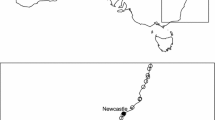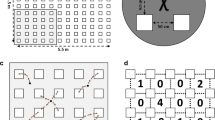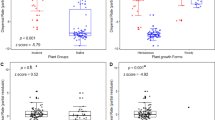Abstract
Naturalized plant species disperse their populations over considerable distances to become invasive. We tested the hypothesis that this shift from naturalization to invasion is facilitated by increased investment of resources in seed dispersal appendages, using an assemblage of naturalized plants of south-eastern Australia. Compared with non-invasive species, we found in both cross-species and independent-contrasts analyses that invasive species invested more heavily in seed dispersal appendages, regardless of the structure present on the seed associated with the mode of dispersal (e.g., wings versus fleshy fruits). Invasive species such as Lonicera japonica, Hedera Helix and Acetosa sagittata were found to invest as much as 60–70% of total diaspore mass in dispersal appendages. The positive relationship between dispersal investment and invasion success was still prevalent after controlling for the effects of plant growth form, seed mass and capacity for vegetative growth. Our findings demonstrate that a plant’s investment in dispersal appendages helps to overcome the dispersal barrier in the shift from naturalization to invasion.



Similar content being viewed by others
References
Alpert P, Bone E, Holzapfel C (2000) Invasiveness, invasibility and the role of environmental stress in the spread of non-native plants. Perspect Plant Ecol Evol Syst 3:52–66
Baker HG (1965) Characteristics and modes of origin of weeds. In: Baker HG, Stebbins GL (eds) The genetics of colonizing species. Academic Press, New York, pp 147–172
Bass DA, Crossman ND, Lawrie SL, Lethbridge MR (2006) The importance of population growth, seed dispersal and habitat suitability in determining plant invasiveness. Euphytica 148:97–109
Botanic Gardens Trust (2009) PlantNET—the plant information network system of botanic gardens trust, Sydney, Australia (V 2.0) [http://plantnet.rbgsyd.nsw.gov.au]
Bradshaw CJA, Giam X, Tan HTW, Brook BW, Sodhi NS (2008) Threat or invasive status in legumes is related to opposite extremes of the same ecological and life-history attributes. J Ecol 96:869–883
Cadotte MW, Murray BR, Lovett-Doust J (2006) Ecological patterns and biological invasions: using regional species inventories in macroecology. Biol Invasions 8:809–821
Cousens RD, Wiegand T, Taghizadeh MS (2008) Small-scale spatial structure within patterns of seed dispersal. Oecologia 158:437–448
Crawley MJ (1993) GLIM for ecologists. Blackwell, Oxford
Crawley MJ (2007) The R book. Wiley, West Sussex
Edwards W, Westoby M (1996) Reserve mass and dispersal investment in relation to geographic range of plant species: phylogenetically independent contrasts. J Biogeogr 23:329–338
Edwards W, Dunlop M, Rodgerson L (2006) The evolution of rewards: seed dispersal, seed size and elaiosome size. J Ecol 94:687–694
Fairley A (1995) Discovering royal national park on foot. Envirobook, Sydney
Fairley A, Moore P (1995) Native plants of the Sydney district: an identification guide. Kangaroo Press, Kenthurst
Godfree R, Lepschi B, Mallinson D (2004) Ecological filtering of exotic plants in an Australian sub-alpine environment. J Veg Sci 15:227–236
Grafen A (1989) The phylogenetic regression. Philos Trans Royal Soc Lond B 326:119–157
Grotkopp E, Rejmánek M, Rost TL (2002) Toward a causal explanation of plant invasiveness: seedling growth and life-history strategies of 29 Pine (Pinus) species. Am Nat 159:396–419
Groves RH (2006) Are some weeds sleeping? Some concepts and reasons. Euphytica 148:111–120
Groves RH, Boden R, Lonsdale M (2005) Jumping the garden Fence: invasive garden plants in Australia and their environmental and agricultural impacts. WWF-Australia, Ultimo
Hamilton MA, Murray BR, Cadotte MW, Hose GC, Baker AC, Harris CJ, Licari D (2005) Life-history correlates of plant invasiveness at regional and continental scales. Ecol Lett 8:1066–1074
Hanspach J, Kühn I, Pyšek P, Boos E, Klotz S (2008) Correlates of naturalization and occupancy of introduced ornamentals in Germany. Perspect Plant Ecol Evol Syst 10:241–250
Harden GJ (1990–1993) Flora of New South Wales. Royal Botanic Gardens. New South Wales University Press, Sydney
Harvey PH, Pagel MD (1991) The comparative method in evolutionary biology. Oxford University Press, Oxford
Hughes L, Dunlop M, French K, Leishman MR, Rice B, Rodgerson L, Westoby M (1994) Predicting dispersal spectra: a minimal set of hypotheses based on plant attributes. J Ecol 82:933–950
Kolar CS, Lodge DM (2001) Progress in invasion biology: predicting invaders. Trends Ecol Evol 16:199–204
Leishman MR, Westoby M, Jurado E (1995) Correlates of seed size variation: a comparison among five temperate floras. J Ecol 83:517–530
Millennium Ecosystem Assessment (2005) Ecosystems and human well-being: biodiversity synthesis. World Resources Institute, Washington, DC
Miller KE, Gorchov DL (2004) The invasive shrub, Lonicera maackii, reduces growth and fecundity of perennial forest herbs. Oecologia 139:359–375
Murray BR, Hose GC (2005) Life-history and ecological correlates of decline and extinction in the endemic Australian frog fauna. Austral Ecology 30:564–571
Murray BR, Thrall PH, Lepschi BJ (2002) Relating species rarity to life history in plants of eastern Australia. Evol Ecol Res 4:937–950
Norman GR, Streiner DL (2000) Biostatistics: the bare essentials, 2nd edn. B.C. Decker, Hamilton
NPWS (2000) Royal national park, Heathcote national park and Garawarra state recreation area: plan of management. NSW National Parks and Wildlife Service, Hurstville
Phillips ML, Murray BR, Leishman MR, Ingram R (2010) The naturalization to invasion transition: are there introduction-history correlates of invasiveness in exotic plants of Australia? Austral Ecol (in press)
PIER (2009) US forest service, Pacific Island ecosystems at risk. Online resource at http://www.hear.org/pier/ accessed [09/01/09]
Pyšek P, Jarošík V (2005) Residence time determines the distribution of alien plants. In: Inderjit (ed) Invasive plants: ecological and agricultural aspects. Birkhäuser, Basel, pp 77–96
Pyšek P, Richardson DM (2007) Traits associated with invasiveness in alien plants: where do we stand? In: Nentwig W (ed) Ecological studies 193, biological invasions. Springer, Berlin, pp 97–125
Pyšek P, Richardson DM (2008) Invasive plants. In: Jørgensen SE, Fath BD (eds) Encyclopedia of ecology. Elsevier, Oxford, pp 2011–2020
Pyšek P, Prach K, Šmilauer P (1995) Relating invasion success to plant traits: an analysis of the Czech alien flora. In: Pyšek P, Prach K, Rejmánek M, Wade M (eds) Plant invasions: general aspects and special problems. SPB Academic, Amsterdam, pp 39–60
Pyšek P, Richardson DM, Williamson M (2004) Predicting and explaining plant invasions through analysis of source area floras: some critical considerations. Divers Distrib 10:179–187
Pyšek P, Richardson DM, Pergl J, Jarošík V, Sixtová Z, Weber E (2008) Geographical and taxonomic biases in invasion ecology. Trends Ecol Evol 23:237–244
Randall RP (2007) The introduced flora of Australia and its weed status. CRC for Australian Weed Management. Department of Agriculture and Food, Western Australia. University of South Australia, Adelaide
Rejmánek M, Richardson DM (1996) What attributes make some plant species more invasive? Ecology 77:1655–1661
Richardson DM, Pyšek P (2006) Plant invasions: merging the concepts of species invasiveness and community invasibility. Prog Phys Geogr 30:409–431
Richardson DM, Pyšek P, Rejmánek M, Barbour MG, Panetta DF, West CJ (2000) Naturalization and invasion of alien plants: concepts and definitions. Divers Distrib 6:93–107
Robson TC, AC Baker, BR Murray (2009) Differences in leaf-litter invertebrate assemblages between radiata pine plantations and neighbouring native eucalypt woodland. Austral Ecol (in press)
Webb CO, Donoghue MJ (2005) Phylomatic: tree assembly for applied phylogenetics. Mol Ecol Notes 5:181–183
Wright IJ, Ackerly DD, Bongers F, Harms KE, Ibarra-Manriquez G, Martinez-Ramos M, Mazer SJ, Muller-Landau HC, Paz H, Pitman NCA, Poorter L, Silman MR, Vriesendorp CF, Webb CO, Westoby M, Wright SJ (2007) Relationships among ecologically important dimensions of plant trait variation in seven neotropical forests. Ann Bot 99:1003–1015
Acknowledgments
We thank Nick Conklin and two anonymous reviewers for helpful comments on an earlier version of the manuscript and Mark Hamilton for his careful assistance with data collection.
Author information
Authors and Affiliations
Corresponding author
Rights and permissions
About this article
Cite this article
Murray, B.R., Phillips, M.L. Investment in seed dispersal structures is linked to invasiveness in exotic plant species of south-eastern Australia. Biol Invasions 12, 2265–2275 (2010). https://doi.org/10.1007/s10530-009-9637-7
Received:
Accepted:
Published:
Issue Date:
DOI: https://doi.org/10.1007/s10530-009-9637-7




